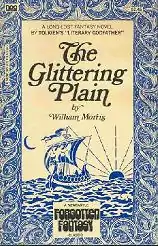| Author | William Morris |
|---|---|
| Illustrator | Walter Crane |
| Country | United Kingdom |
| Language | English |
| Genre | Fantasy novel |
| Publisher | Macmillan/Kelmscott Press |
Publication date | 1890/1891 |
| Media type | Print[1] (first published in the English Illustrated Magazine, issued as a book by the Kelmscott Press). |
The Story of the Glittering Plain (full title: The Story of the Glittering Plain which has been also called the Land of Living Men or the Acre of the Undying) is an 1891 fantasy novel by William Morris, perhaps the first modern fantasy writer to unite an imaginary world with the element of the supernatural, and thus the precursor of much of present-day fantasy literature.[2] It is also important for its exploration of the socialist themes that interested Morris.
His earlier fantasies The House of the Wolfings and The Roots of the Mountains were to some degree historical novels. Like these The Story of the Glittering Plain is set in a world similar to the distant past of northern Europe. Morris would go on to develop the new genre established in this work in such later fantasies as Child Christopher and Goldilind the Fair, The Wood Beyond the World, The Well at the World's End, and The Water of the Wondrous Isles.[3]
Plot introduction

The book concerns the quest of Hallblithe of the House of the Raven to rescue his fiancée the Hostage, who has been kidnapped by pirates, which ultimately takes him to the utopian Land of the Glittering Plain, also known as the Acre of the Undying or the Land of the Living Men, whose inhabitants are supposedly immortal.
Publication history
First printed in The English Illustrated Magazine, Vol. VII, 1890,[4] the story was printed in book form the following year by the Kelmscott Press, Morris's own newly founded private press.
Kelmscott editions
The first Kelmscott edition was not illustrated, but used decorated capitals and Morris's "Golden" typeface (after Nicolas Jenson). A second edition appeared in 1894.[1] Morris increased the size of the book from small to large quarto, and changed the typeface to "Troy" (a more Gothic design). Walter Crane supplied illustrations on a profit-sharing basis: these were designed as woodcuts in accordance with Morris's commitment to techniques typical of 15th and 16th-century European book production. Although Crane had trained as a wood engraver, it was agreed that the illustrations could be "cut on wood" by someone else.[5]
The number of copies printed by the Kelmscott Press was small. According to the British Library, which has several copies, the 1894 edition was a "limited ed. of 250 paper copies (priced 5 gns) and 7 vellum copies (£20)".[1]
Other editions
Although the Kelmscott Press continued in existence until 1898, The Story of the Glittering Plain was, in 1896, transferred to Longmans, Green and Co., a large-scale publisher. It was republished (as The Glittering Plain) by the Newcastle Publishing Company as the first volume of the Newcastle Forgotten Fantasy Library in September, 1973.
Copyright
The copyright for this story has expired in the United States, and thus now resides in the public domain there. The text is available via Project Gutenberg (transcribed from the 1913 Longmans, Green and Co. edition).
References
- 1 2 3 The Story of the Glittering Plain which has been also called the Land of Living Men or the Acre of the Undying/ written by William Morris British Library catalogue.
- ↑ L. Sprague de Camp, Literary Swordsmen and Sorcerers: The Makers of Heroic Fantasy, p 40 ISBN 0-87054-076-9
- ↑ L. Sprague de Camp, Literary Swordsmen and Sorcerers: The Makers of Heroic Fantasy, p 42-5 ISBN 0-87054-076-9
- ↑
- ↑ Letters and related material from William Morris and the Kelmscott Press. John Rylands Library (retrieved via ELGAR: Electronic Gateway to Archives at Rylands).
External links
- The Story of the Glittering Plain the two Kelmscott editions
- The Story of the Glittering Plain at Project Gutenberg
 The Story of the Glittering Plain public domain audiobook at LibriVox
The Story of the Glittering Plain public domain audiobook at LibriVox